Entrepreneurial Leadership: Development, Teamwork, and Recommendations
VerifiedAdded on 2023/06/11
|19
|5604
|163
Essay
AI Summary
This essay provides a detailed exploration of entrepreneurial leadership, emphasizing its role in people development, teamwork, and ethical organizational practices. It discusses the characteristics of entrepreneurial leaders, such as communication, motivation, and strategic thinking, and their impact on team performance and organizational culture. The essay also applies theoretical models like the GROW model and the five disciplines of effective teams to address key business challenges. Furthermore, it offers justified recommendations for achieving business objectives and meeting expectations in transforming teamwork, while also identifying areas for personal leadership development. The analysis incorporates both primary and secondary sources to provide a comprehensive understanding of entrepreneurial leadership in various contexts, including higher education.
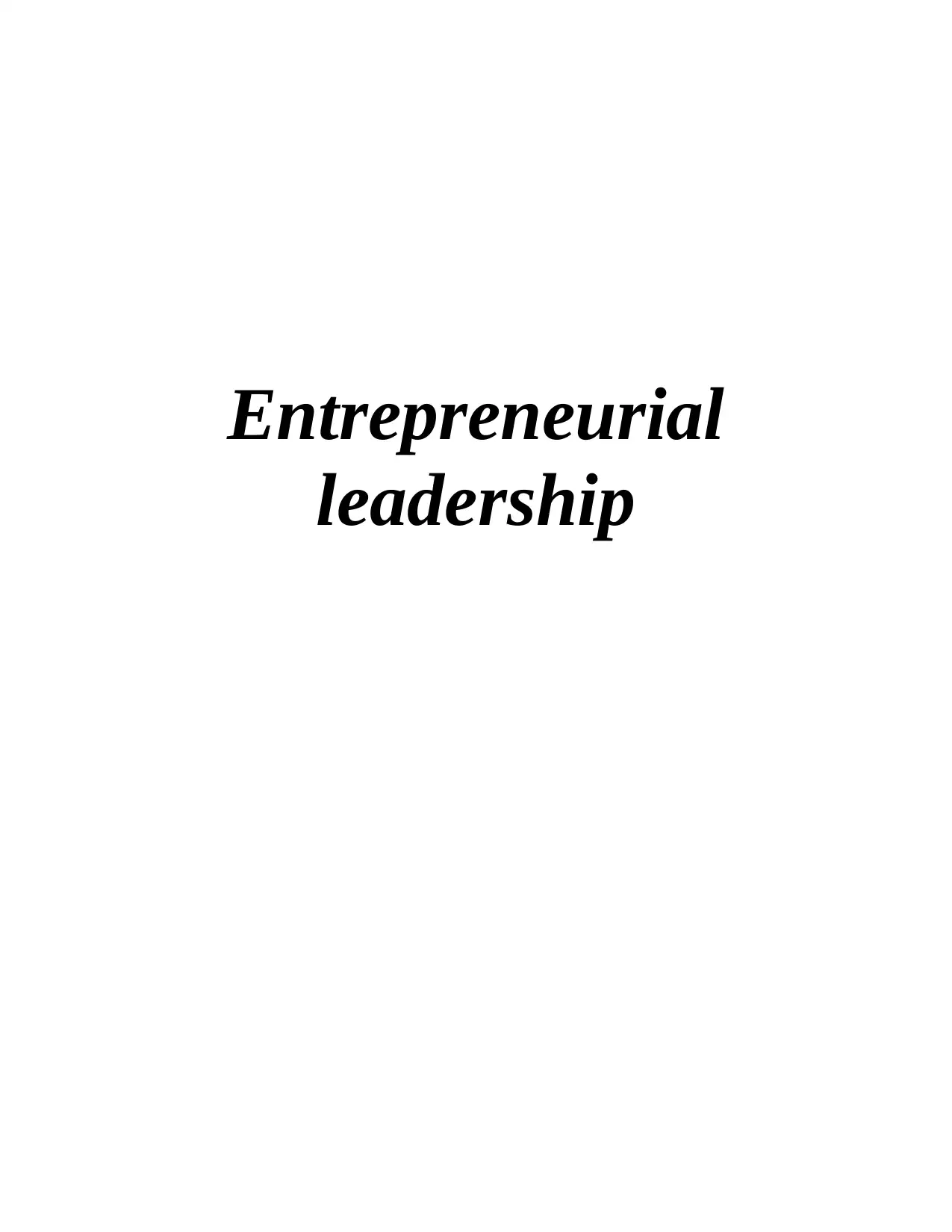
Entrepreneurial
leadership
leadership
Paraphrase This Document
Need a fresh take? Get an instant paraphrase of this document with our AI Paraphraser
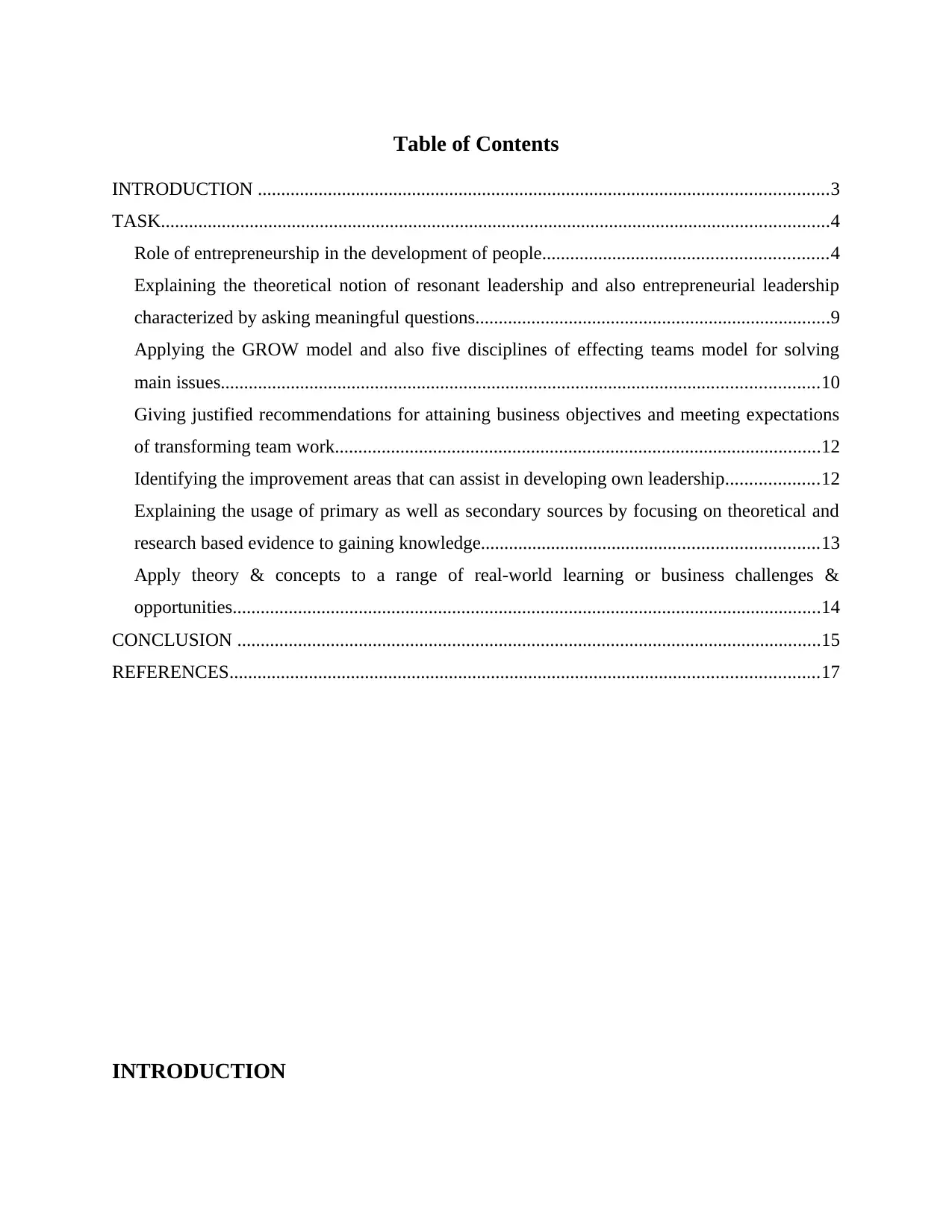
Table of Contents
INTRODUCTION ..........................................................................................................................3
TASK...............................................................................................................................................4
Role of entrepreneurship in the development of people.............................................................4
Explaining the theoretical notion of resonant leadership and also entrepreneurial leadership
characterized by asking meaningful questions............................................................................9
Applying the GROW model and also five disciplines of effecting teams model for solving
main issues................................................................................................................................10
Giving justified recommendations for attaining business objectives and meeting expectations
of transforming team work........................................................................................................12
Identifying the improvement areas that can assist in developing own leadership....................12
Explaining the usage of primary as well as secondary sources by focusing on theoretical and
research based evidence to gaining knowledge........................................................................13
Apply theory & concepts to a range of real-world learning or business challenges &
opportunities..............................................................................................................................14
CONCLUSION .............................................................................................................................15
REFERENCES..............................................................................................................................17
INTRODUCTION
INTRODUCTION ..........................................................................................................................3
TASK...............................................................................................................................................4
Role of entrepreneurship in the development of people.............................................................4
Explaining the theoretical notion of resonant leadership and also entrepreneurial leadership
characterized by asking meaningful questions............................................................................9
Applying the GROW model and also five disciplines of effecting teams model for solving
main issues................................................................................................................................10
Giving justified recommendations for attaining business objectives and meeting expectations
of transforming team work........................................................................................................12
Identifying the improvement areas that can assist in developing own leadership....................12
Explaining the usage of primary as well as secondary sources by focusing on theoretical and
research based evidence to gaining knowledge........................................................................13
Apply theory & concepts to a range of real-world learning or business challenges &
opportunities..............................................................................................................................14
CONCLUSION .............................................................................................................................15
REFERENCES..............................................................................................................................17
INTRODUCTION
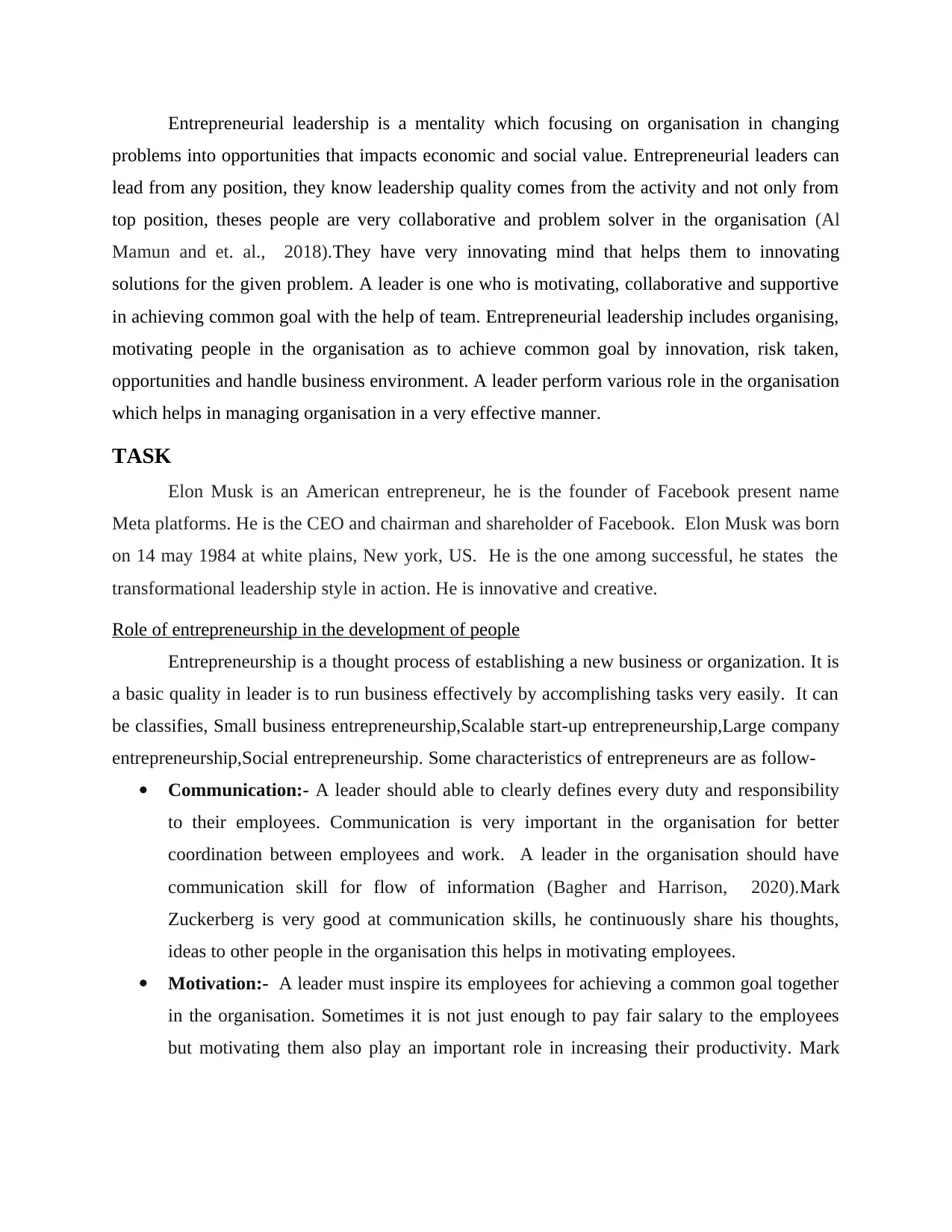
Entrepreneurial leadership is a mentality which focusing on organisation in changing
problems into opportunities that impacts economic and social value. Entrepreneurial leaders can
lead from any position, they know leadership quality comes from the activity and not only from
top position, theses people are very collaborative and problem solver in the organisation (Al
Mamun and et. al., 2018).They have very innovating mind that helps them to innovating
solutions for the given problem. A leader is one who is motivating, collaborative and supportive
in achieving common goal with the help of team. Entrepreneurial leadership includes organising,
motivating people in the organisation as to achieve common goal by innovation, risk taken,
opportunities and handle business environment. A leader perform various role in the organisation
which helps in managing organisation in a very effective manner.
TASK
Elon Musk is an American entrepreneur, he is the founder of Facebook present name
Meta platforms. He is the CEO and chairman and shareholder of Facebook. Elon Musk was born
on 14 may 1984 at white plains, New york, US. He is the one among successful, he states the
transformational leadership style in action. He is innovative and creative.
Role of entrepreneurship in the development of people
Entrepreneurship is a thought process of establishing a new business or organization. It is
a basic quality in leader is to run business effectively by accomplishing tasks very easily. It can
be classifies, Small business entrepreneurship,Scalable start-up entrepreneurship,Large company
entrepreneurship,Social entrepreneurship. Some characteristics of entrepreneurs are as follow-
Communication:- A leader should able to clearly defines every duty and responsibility
to their employees. Communication is very important in the organisation for better
coordination between employees and work. A leader in the organisation should have
communication skill for flow of information (Bagher and Harrison, 2020).Mark
Zuckerberg is very good at communication skills, he continuously share his thoughts,
ideas to other people in the organisation this helps in motivating employees.
Motivation:- A leader must inspire its employees for achieving a common goal together
in the organisation. Sometimes it is not just enough to pay fair salary to the employees
but motivating them also play an important role in increasing their productivity. Mark
problems into opportunities that impacts economic and social value. Entrepreneurial leaders can
lead from any position, they know leadership quality comes from the activity and not only from
top position, theses people are very collaborative and problem solver in the organisation (Al
Mamun and et. al., 2018).They have very innovating mind that helps them to innovating
solutions for the given problem. A leader is one who is motivating, collaborative and supportive
in achieving common goal with the help of team. Entrepreneurial leadership includes organising,
motivating people in the organisation as to achieve common goal by innovation, risk taken,
opportunities and handle business environment. A leader perform various role in the organisation
which helps in managing organisation in a very effective manner.
TASK
Elon Musk is an American entrepreneur, he is the founder of Facebook present name
Meta platforms. He is the CEO and chairman and shareholder of Facebook. Elon Musk was born
on 14 may 1984 at white plains, New york, US. He is the one among successful, he states the
transformational leadership style in action. He is innovative and creative.
Role of entrepreneurship in the development of people
Entrepreneurship is a thought process of establishing a new business or organization. It is
a basic quality in leader is to run business effectively by accomplishing tasks very easily. It can
be classifies, Small business entrepreneurship,Scalable start-up entrepreneurship,Large company
entrepreneurship,Social entrepreneurship. Some characteristics of entrepreneurs are as follow-
Communication:- A leader should able to clearly defines every duty and responsibility
to their employees. Communication is very important in the organisation for better
coordination between employees and work. A leader in the organisation should have
communication skill for flow of information (Bagher and Harrison, 2020).Mark
Zuckerberg is very good at communication skills, he continuously share his thoughts,
ideas to other people in the organisation this helps in motivating employees.
Motivation:- A leader must inspire its employees for achieving a common goal together
in the organisation. Sometimes it is not just enough to pay fair salary to the employees
but motivating them also play an important role in increasing their productivity. Mark
⊘ This is a preview!⊘
Do you want full access?
Subscribe today to unlock all pages.

Trusted by 1+ million students worldwide

Zuckerberg implemented many motivational theories in order to enhance people
performance, one of the motivation theory is ocean motivation theory.
Mentor:- Leader is a mentor or guide to its employees. They make them feel motivated
and confident at the same time by keep monitor their performance, leader guide them
how to do tasks.
Delegating:- It is a skill in which a leader delegates work according to capability of the
employees, it is a sign of strong leader. It is a duty of a leader to allocate work to people
and provide them enough resources so that they can fulfil their duty in a effective manner
(Dabić and et. al., 2021). In context to Mark Zuckerberg he is the one of the best leader,
he arrange all the employees in terms of duty and responsibility according to their calibre
so that they can perform their task easily.
Positivity:- A leader is one who can able to make business environment very positive by
their motivation, support and duty assign. A positive nature can help in achieve goals
very easily. A employees willing to work only that place where he finds a best
environment. In context to Mark Zuckerberg he has very positive nature, he takes care of
his employees and he is very much dedicated towards growth of its employees. He
keeps encouraging and motivating to people in the organisation as to increase efficiency.
Creativity:- A leader have to take various decisions to increase efficiency in business,
for this he should have very creative mind so he can take a right decision which can help
for both organisation and people. In link with Mark Zuckerberg he has the ability to take
right decisions for its people and organisation.
Execute strategy:- It is a duty of the leader to not only think big but they have to
implement goal into real activities. In context to Mark Zuckerberg he able to implement
plans to real life experience so that it can help in business-led environment.
Role of leader in development of team:-
A leader provides the direction to team and then institutes rules which is designed to achieving
goals. a team leader is a crucial factor in success of the company, and it is also important for
motivating and supporting employees as to maintain high team spirit. With clear and accurate
communication they can able to set objectives and guide team members in a more effective
performance, one of the motivation theory is ocean motivation theory.
Mentor:- Leader is a mentor or guide to its employees. They make them feel motivated
and confident at the same time by keep monitor their performance, leader guide them
how to do tasks.
Delegating:- It is a skill in which a leader delegates work according to capability of the
employees, it is a sign of strong leader. It is a duty of a leader to allocate work to people
and provide them enough resources so that they can fulfil their duty in a effective manner
(Dabić and et. al., 2021). In context to Mark Zuckerberg he is the one of the best leader,
he arrange all the employees in terms of duty and responsibility according to their calibre
so that they can perform their task easily.
Positivity:- A leader is one who can able to make business environment very positive by
their motivation, support and duty assign. A positive nature can help in achieve goals
very easily. A employees willing to work only that place where he finds a best
environment. In context to Mark Zuckerberg he has very positive nature, he takes care of
his employees and he is very much dedicated towards growth of its employees. He
keeps encouraging and motivating to people in the organisation as to increase efficiency.
Creativity:- A leader have to take various decisions to increase efficiency in business,
for this he should have very creative mind so he can take a right decision which can help
for both organisation and people. In link with Mark Zuckerberg he has the ability to take
right decisions for its people and organisation.
Execute strategy:- It is a duty of the leader to not only think big but they have to
implement goal into real activities. In context to Mark Zuckerberg he able to implement
plans to real life experience so that it can help in business-led environment.
Role of leader in development of team:-
A leader provides the direction to team and then institutes rules which is designed to achieving
goals. a team leader is a crucial factor in success of the company, and it is also important for
motivating and supporting employees as to maintain high team spirit. With clear and accurate
communication they can able to set objectives and guide team members in a more effective
Paraphrase This Document
Need a fresh take? Get an instant paraphrase of this document with our AI Paraphraser
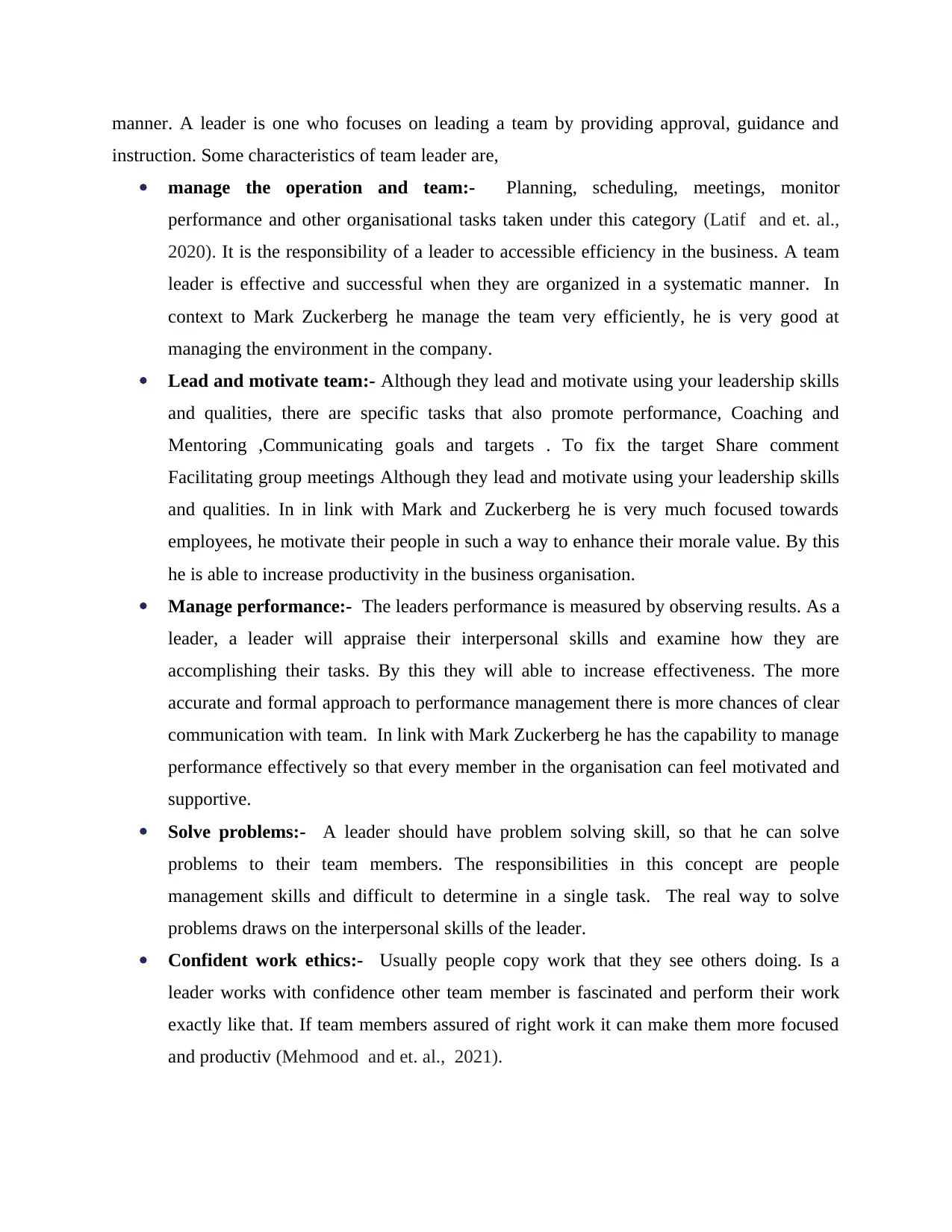
manner. A leader is one who focuses on leading a team by providing approval, guidance and
instruction. Some characteristics of team leader are,
manage the operation and team:- Planning, scheduling, meetings, monitor
performance and other organisational tasks taken under this category (Latif and et. al.,
2020). It is the responsibility of a leader to accessible efficiency in the business. A team
leader is effective and successful when they are organized in a systematic manner. In
context to Mark Zuckerberg he manage the team very efficiently, he is very good at
managing the environment in the company.
Lead and motivate team:- Although they lead and motivate using your leadership skills
and qualities, there are specific tasks that also promote performance, Coaching and
Mentoring ,Communicating goals and targets . To fix the target Share comment
Facilitating group meetings Although they lead and motivate using your leadership skills
and qualities. In in link with Mark and Zuckerberg he is very much focused towards
employees, he motivate their people in such a way to enhance their morale value. By this
he is able to increase productivity in the business organisation.
Manage performance:- The leaders performance is measured by observing results. As a
leader, a leader will appraise their interpersonal skills and examine how they are
accomplishing their tasks. By this they will able to increase effectiveness. The more
accurate and formal approach to performance management there is more chances of clear
communication with team. In link with Mark Zuckerberg he has the capability to manage
performance effectively so that every member in the organisation can feel motivated and
supportive.
Solve problems:- A leader should have problem solving skill, so that he can solve
problems to their team members. The responsibilities in this concept are people
management skills and difficult to determine in a single task. The real way to solve
problems draws on the interpersonal skills of the leader.
Confident work ethics:- Usually people copy work that they see others doing. Is a
leader works with confidence other team member is fascinated and perform their work
exactly like that. If team members assured of right work it can make them more focused
and productiv (Mehmood and et. al., 2021).
instruction. Some characteristics of team leader are,
manage the operation and team:- Planning, scheduling, meetings, monitor
performance and other organisational tasks taken under this category (Latif and et. al.,
2020). It is the responsibility of a leader to accessible efficiency in the business. A team
leader is effective and successful when they are organized in a systematic manner. In
context to Mark Zuckerberg he manage the team very efficiently, he is very good at
managing the environment in the company.
Lead and motivate team:- Although they lead and motivate using your leadership skills
and qualities, there are specific tasks that also promote performance, Coaching and
Mentoring ,Communicating goals and targets . To fix the target Share comment
Facilitating group meetings Although they lead and motivate using your leadership skills
and qualities. In in link with Mark and Zuckerberg he is very much focused towards
employees, he motivate their people in such a way to enhance their morale value. By this
he is able to increase productivity in the business organisation.
Manage performance:- The leaders performance is measured by observing results. As a
leader, a leader will appraise their interpersonal skills and examine how they are
accomplishing their tasks. By this they will able to increase effectiveness. The more
accurate and formal approach to performance management there is more chances of clear
communication with team. In link with Mark Zuckerberg he has the capability to manage
performance effectively so that every member in the organisation can feel motivated and
supportive.
Solve problems:- A leader should have problem solving skill, so that he can solve
problems to their team members. The responsibilities in this concept are people
management skills and difficult to determine in a single task. The real way to solve
problems draws on the interpersonal skills of the leader.
Confident work ethics:- Usually people copy work that they see others doing. Is a
leader works with confidence other team member is fascinated and perform their work
exactly like that. If team members assured of right work it can make them more focused
and productiv (Mehmood and et. al., 2021).

Develop team strengths and improve weakness:- A good team leader is always care
about their employee and they try to help them by overcoming their weakness and
enhance their strengths.
Role of leader in development of ethical organisation:-
Ethical management should be a aware decision. As Fred Kofman writes in his ee-e book
Conscious Business, “To be aware way to be awake, mindful. To stay consciously way to be
open to perceiving the arena round and inside us, to recognize our circumstances, and to
determine the way to reply to them in methods that honour our needs, values, and goals.” some
of the characteristics of a2 good leader are,
Show respect for others:- Showing respect to others is required in a leader to recognize
the intrinsic value of others and they should know how to behave with the people. A
leader should have this skills to understand the worth of others. They should admire
others and give attention to their thoughts and ideas (Pauceanu and et. al., 2021). By this
they can able to make loyalty and trust with their subordinates. In context to Mark
Zuckerberg he is the leading entrepreneur because he values others ideas, opinions and he
knows how to respect others.
Treat all stakeholders fairly:- Ethical leader treats everyone and their determination to
maintain fairness. Ethical leaders seek to treat everyone whose decisions may affect them
fairly and equally. Equality is also a priority for moral leaders and should be an important
factor in their decision-making (Yang, Pu and Guan, 2019).Moral leaders must act from
special treatment of others Failure to do so creates winners and losers , internal and
external groups and can cause rancour between those receiving special treatment and
those not receiving special treatment. The only omission occurs when an individual's
particular situation requires special direction to achieve a fair outcome.
Work toward a common goal:- Ethical leaders seek to pursue social or institutional
goals that are higher than personal goals. This responsibility requires an moral leader to
serve a greater good by meeting the needs of others (Paudel, 2020). This type of
behaviour is an example of altruism, a unrelenting dedication to improving the well-being
of others. Selfless behaviour can manifest itself in corporate environments through
actions such as mentoring,empowerment.
about their employee and they try to help them by overcoming their weakness and
enhance their strengths.
Role of leader in development of ethical organisation:-
Ethical management should be a aware decision. As Fred Kofman writes in his ee-e book
Conscious Business, “To be aware way to be awake, mindful. To stay consciously way to be
open to perceiving the arena round and inside us, to recognize our circumstances, and to
determine the way to reply to them in methods that honour our needs, values, and goals.” some
of the characteristics of a2 good leader are,
Show respect for others:- Showing respect to others is required in a leader to recognize
the intrinsic value of others and they should know how to behave with the people. A
leader should have this skills to understand the worth of others. They should admire
others and give attention to their thoughts and ideas (Pauceanu and et. al., 2021). By this
they can able to make loyalty and trust with their subordinates. In context to Mark
Zuckerberg he is the leading entrepreneur because he values others ideas, opinions and he
knows how to respect others.
Treat all stakeholders fairly:- Ethical leader treats everyone and their determination to
maintain fairness. Ethical leaders seek to treat everyone whose decisions may affect them
fairly and equally. Equality is also a priority for moral leaders and should be an important
factor in their decision-making (Yang, Pu and Guan, 2019).Moral leaders must act from
special treatment of others Failure to do so creates winners and losers , internal and
external groups and can cause rancour between those receiving special treatment and
those not receiving special treatment. The only omission occurs when an individual's
particular situation requires special direction to achieve a fair outcome.
Work toward a common goal:- Ethical leaders seek to pursue social or institutional
goals that are higher than personal goals. This responsibility requires an moral leader to
serve a greater good by meeting the needs of others (Paudel, 2020). This type of
behaviour is an example of altruism, a unrelenting dedication to improving the well-being
of others. Selfless behaviour can manifest itself in corporate environments through
actions such as mentoring,empowerment.
⊘ This is a preview!⊘
Do you want full access?
Subscribe today to unlock all pages.

Trusted by 1+ million students worldwide

Build team:- A leader creates a team in the management in which they increasing
motivation for the team members by this their morale increases. A ethical leader
motivates its team members by listening their ideas and opinions so that they can feel
valued. Mark Zuckerberg is a good leader and he is handling his team very effectively.
Entrepreneurial leadership
The entrepreneurial leadership states the form of leadership in which the actions are taken
for aiming the establishment of business on the individual basis. In addition to this, the actions
related to implementing company innovation as well as strategies assist in exploiting the
opportunities present in market. In context to higher education institution, the capabilities of
entrepreneurship leadership are helpful as it can support the leader to transform the challenges
into the opportunities for initiating the growth process. It can also assist the higher education
institution to increase the social as well as economic advantage in most effective manner(Haim
Faridian, 2022). There are important characteristics that are connected with the entrepreneurial
type of leadership are:
Supportive:
This key feature of entrepreneurial leadership represent the importance of giving support
to the subordinate staff members as well as other individuals for improving their entrepreneurial
skills and knowledge. In relation to higher education setting, the main focus is on developing the
behaviour of staff members by offering them with support for developing entrepreneurship skills
in proper manner.
Learning:
This type of feature is driven by practises related to continuously questioning the current
business processes and to take review of ideas like organisational goals, stakeholder relationship,
deployment of suitable resources ass well as identifying the ways for the improvement. In
context to higher education setting, the practise of critically reviewing the conventional practises
and asking basic questions can form the working environment in which learning and continuous
development are welcomed.
Linking entrepreneurship and strategic management:
The concept related with formulating company with entrepreneurial skills is implied in
this type of feature. In the case of leading higher education teams, the entrepreneurial skills of all
staff members need to be improved for the purpose of attaining the strategic objectives of
motivation for the team members by this their morale increases. A ethical leader
motivates its team members by listening their ideas and opinions so that they can feel
valued. Mark Zuckerberg is a good leader and he is handling his team very effectively.
Entrepreneurial leadership
The entrepreneurial leadership states the form of leadership in which the actions are taken
for aiming the establishment of business on the individual basis. In addition to this, the actions
related to implementing company innovation as well as strategies assist in exploiting the
opportunities present in market. In context to higher education institution, the capabilities of
entrepreneurship leadership are helpful as it can support the leader to transform the challenges
into the opportunities for initiating the growth process. It can also assist the higher education
institution to increase the social as well as economic advantage in most effective manner(Haim
Faridian, 2022). There are important characteristics that are connected with the entrepreneurial
type of leadership are:
Supportive:
This key feature of entrepreneurial leadership represent the importance of giving support
to the subordinate staff members as well as other individuals for improving their entrepreneurial
skills and knowledge. In relation to higher education setting, the main focus is on developing the
behaviour of staff members by offering them with support for developing entrepreneurship skills
in proper manner.
Learning:
This type of feature is driven by practises related to continuously questioning the current
business processes and to take review of ideas like organisational goals, stakeholder relationship,
deployment of suitable resources ass well as identifying the ways for the improvement. In
context to higher education setting, the practise of critically reviewing the conventional practises
and asking basic questions can form the working environment in which learning and continuous
development are welcomed.
Linking entrepreneurship and strategic management:
The concept related with formulating company with entrepreneurial skills is implied in
this type of feature. In the case of leading higher education teams, the entrepreneurial skills of all
staff members need to be improved for the purpose of attaining the strategic objectives of
Paraphrase This Document
Need a fresh take? Get an instant paraphrase of this document with our AI Paraphraser
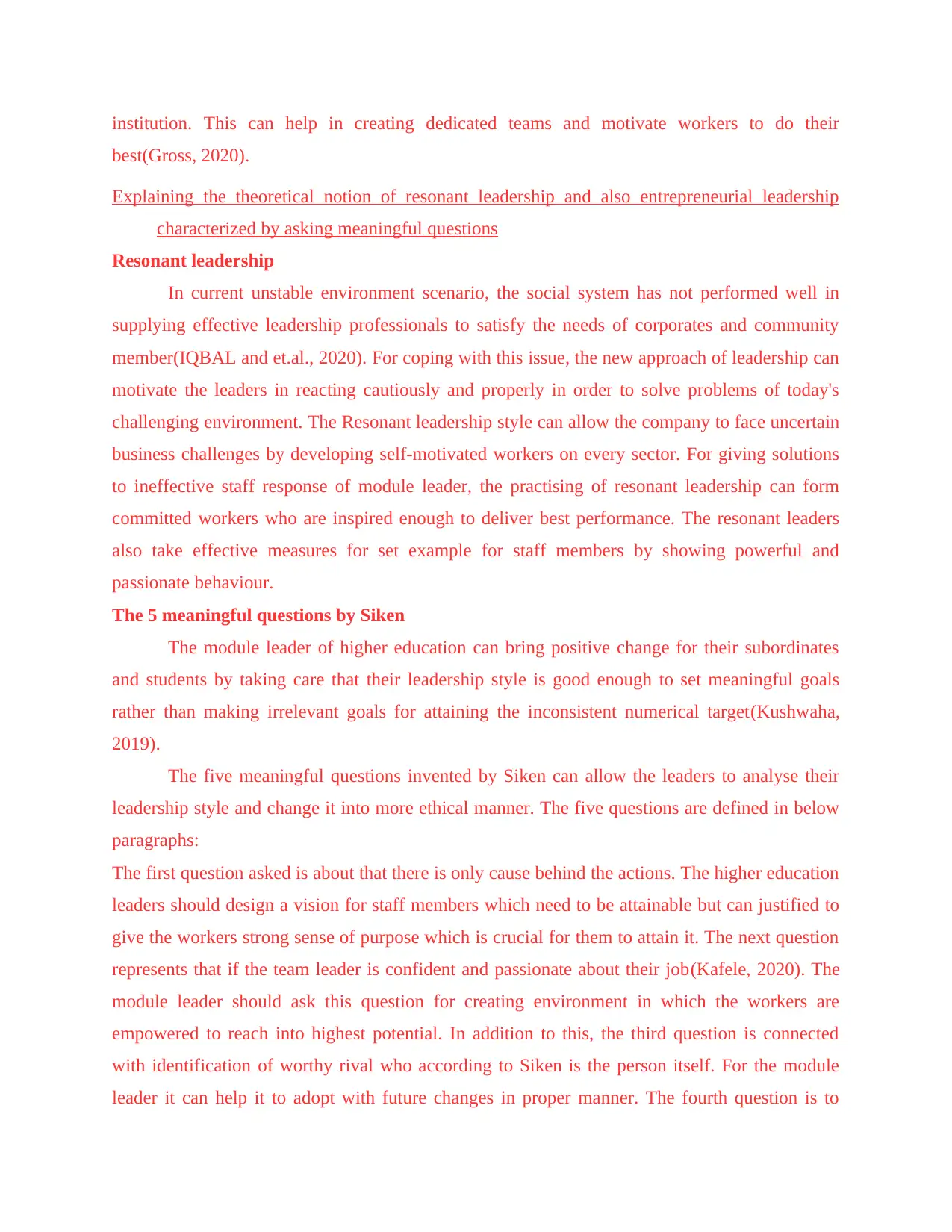
institution. This can help in creating dedicated teams and motivate workers to do their
best(Gross, 2020).
Explaining the theoretical notion of resonant leadership and also entrepreneurial leadership
characterized by asking meaningful questions
Resonant leadership
In current unstable environment scenario, the social system has not performed well in
supplying effective leadership professionals to satisfy the needs of corporates and community
member(IQBAL and et.al., 2020). For coping with this issue, the new approach of leadership can
motivate the leaders in reacting cautiously and properly in order to solve problems of today's
challenging environment. The Resonant leadership style can allow the company to face uncertain
business challenges by developing self-motivated workers on every sector. For giving solutions
to ineffective staff response of module leader, the practising of resonant leadership can form
committed workers who are inspired enough to deliver best performance. The resonant leaders
also take effective measures for set example for staff members by showing powerful and
passionate behaviour.
The 5 meaningful questions by Siken
The module leader of higher education can bring positive change for their subordinates
and students by taking care that their leadership style is good enough to set meaningful goals
rather than making irrelevant goals for attaining the inconsistent numerical target(Kushwaha,
2019).
The five meaningful questions invented by Siken can allow the leaders to analyse their
leadership style and change it into more ethical manner. The five questions are defined in below
paragraphs:
The first question asked is about that there is only cause behind the actions. The higher education
leaders should design a vision for staff members which need to be attainable but can justified to
give the workers strong sense of purpose which is crucial for them to attain it. The next question
represents that if the team leader is confident and passionate about their job(Kafele, 2020). The
module leader should ask this question for creating environment in which the workers are
empowered to reach into highest potential. In addition to this, the third question is connected
with identification of worthy rival who according to Siken is the person itself. For the module
leader it can help it to adopt with future changes in proper manner. The fourth question is to
best(Gross, 2020).
Explaining the theoretical notion of resonant leadership and also entrepreneurial leadership
characterized by asking meaningful questions
Resonant leadership
In current unstable environment scenario, the social system has not performed well in
supplying effective leadership professionals to satisfy the needs of corporates and community
member(IQBAL and et.al., 2020). For coping with this issue, the new approach of leadership can
motivate the leaders in reacting cautiously and properly in order to solve problems of today's
challenging environment. The Resonant leadership style can allow the company to face uncertain
business challenges by developing self-motivated workers on every sector. For giving solutions
to ineffective staff response of module leader, the practising of resonant leadership can form
committed workers who are inspired enough to deliver best performance. The resonant leaders
also take effective measures for set example for staff members by showing powerful and
passionate behaviour.
The 5 meaningful questions by Siken
The module leader of higher education can bring positive change for their subordinates
and students by taking care that their leadership style is good enough to set meaningful goals
rather than making irrelevant goals for attaining the inconsistent numerical target(Kushwaha,
2019).
The five meaningful questions invented by Siken can allow the leaders to analyse their
leadership style and change it into more ethical manner. The five questions are defined in below
paragraphs:
The first question asked is about that there is only cause behind the actions. The higher education
leaders should design a vision for staff members which need to be attainable but can justified to
give the workers strong sense of purpose which is crucial for them to attain it. The next question
represents that if the team leader is confident and passionate about their job(Kafele, 2020). The
module leader should ask this question for creating environment in which the workers are
empowered to reach into highest potential. In addition to this, the third question is connected
with identification of worthy rival who according to Siken is the person itself. For the module
leader it can help it to adopt with future changes in proper manner. The fourth question is to
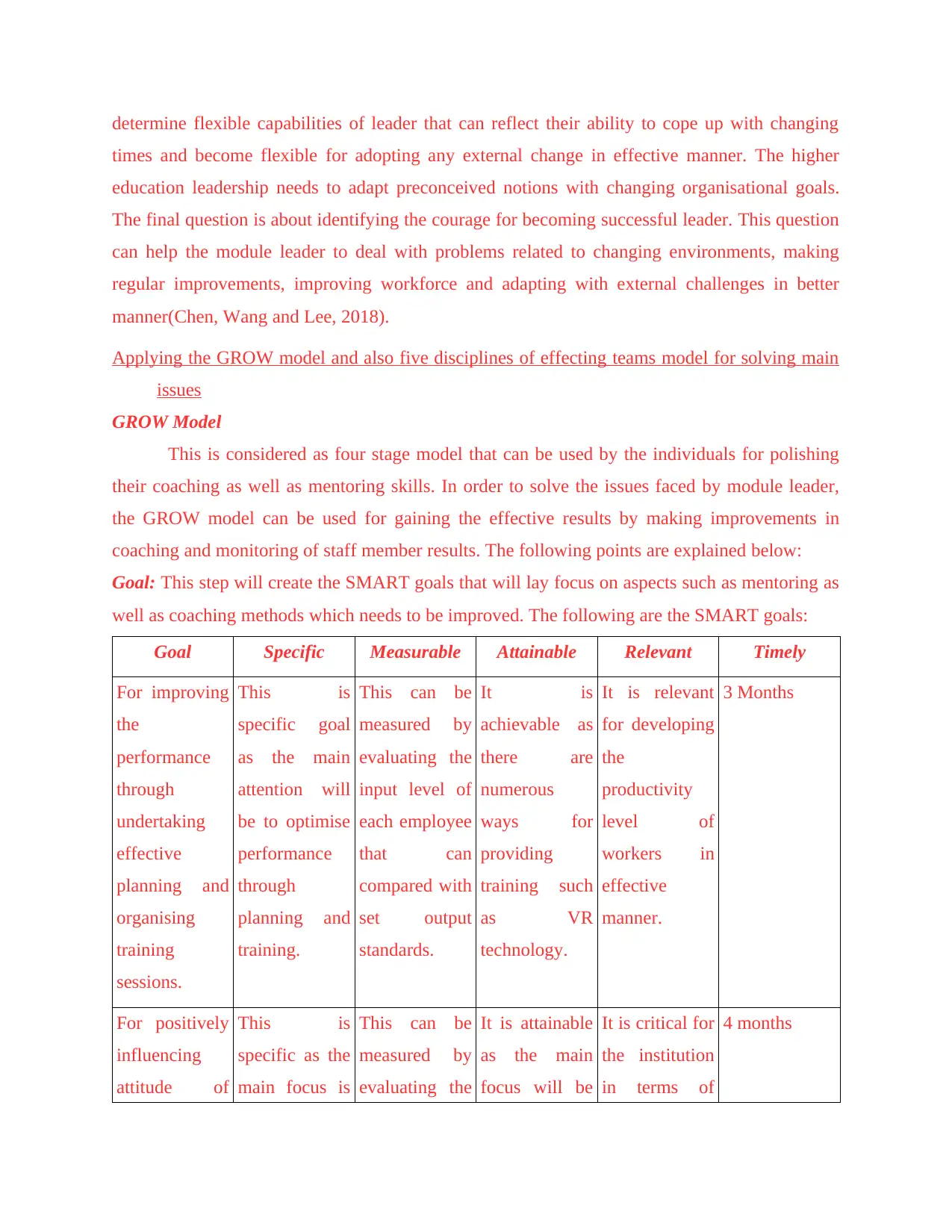
determine flexible capabilities of leader that can reflect their ability to cope up with changing
times and become flexible for adopting any external change in effective manner. The higher
education leadership needs to adapt preconceived notions with changing organisational goals.
The final question is about identifying the courage for becoming successful leader. This question
can help the module leader to deal with problems related to changing environments, making
regular improvements, improving workforce and adapting with external challenges in better
manner(Chen, Wang and Lee, 2018).
Applying the GROW model and also five disciplines of effecting teams model for solving main
issues
GROW Model
This is considered as four stage model that can be used by the individuals for polishing
their coaching as well as mentoring skills. In order to solve the issues faced by module leader,
the GROW model can be used for gaining the effective results by making improvements in
coaching and monitoring of staff member results. The following points are explained below:
Goal: This step will create the SMART goals that will lay focus on aspects such as mentoring as
well as coaching methods which needs to be improved. The following are the SMART goals:
Goal Specific Measurable Attainable Relevant Timely
For improving
the
performance
through
undertaking
effective
planning and
organising
training
sessions.
This is
specific goal
as the main
attention will
be to optimise
performance
through
planning and
training.
This can be
measured by
evaluating the
input level of
each employee
that can
compared with
set output
standards.
It is
achievable as
there are
numerous
ways for
providing
training such
as VR
technology.
It is relevant
for developing
the
productivity
level of
workers in
effective
manner.
3 Months
For positively
influencing
attitude of
This is
specific as the
main focus is
This can be
measured by
evaluating the
It is attainable
as the main
focus will be
It is critical for
the institution
in terms of
4 months
times and become flexible for adopting any external change in effective manner. The higher
education leadership needs to adapt preconceived notions with changing organisational goals.
The final question is about identifying the courage for becoming successful leader. This question
can help the module leader to deal with problems related to changing environments, making
regular improvements, improving workforce and adapting with external challenges in better
manner(Chen, Wang and Lee, 2018).
Applying the GROW model and also five disciplines of effecting teams model for solving main
issues
GROW Model
This is considered as four stage model that can be used by the individuals for polishing
their coaching as well as mentoring skills. In order to solve the issues faced by module leader,
the GROW model can be used for gaining the effective results by making improvements in
coaching and monitoring of staff member results. The following points are explained below:
Goal: This step will create the SMART goals that will lay focus on aspects such as mentoring as
well as coaching methods which needs to be improved. The following are the SMART goals:
Goal Specific Measurable Attainable Relevant Timely
For improving
the
performance
through
undertaking
effective
planning and
organising
training
sessions.
This is
specific goal
as the main
attention will
be to optimise
performance
through
planning and
training.
This can be
measured by
evaluating the
input level of
each employee
that can
compared with
set output
standards.
It is
achievable as
there are
numerous
ways for
providing
training such
as VR
technology.
It is relevant
for developing
the
productivity
level of
workers in
effective
manner.
3 Months
For positively
influencing
attitude of
This is
specific as the
main focus is
This can be
measured by
evaluating the
It is attainable
as the main
focus will be
It is critical for
the institution
in terms of
4 months
⊘ This is a preview!⊘
Do you want full access?
Subscribe today to unlock all pages.

Trusted by 1+ million students worldwide
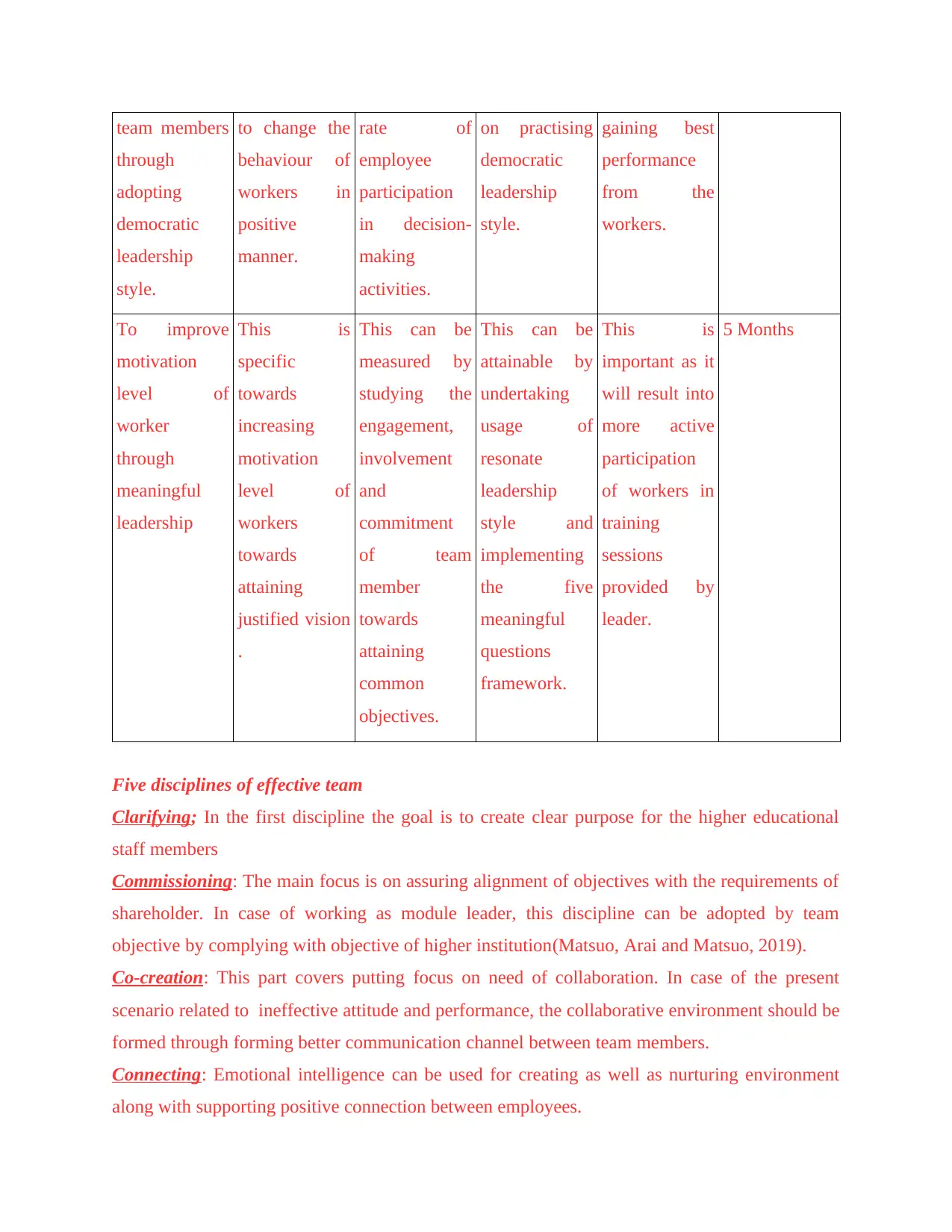
team members
through
adopting
democratic
leadership
style.
to change the
behaviour of
workers in
positive
manner.
rate of
employee
participation
in decision-
making
activities.
on practising
democratic
leadership
style.
gaining best
performance
from the
workers.
To improve
motivation
level of
worker
through
meaningful
leadership
This is
specific
towards
increasing
motivation
level of
workers
towards
attaining
justified vision
.
This can be
measured by
studying the
engagement,
involvement
and
commitment
of team
member
towards
attaining
common
objectives.
This can be
attainable by
undertaking
usage of
resonate
leadership
style and
implementing
the five
meaningful
questions
framework.
This is
important as it
will result into
more active
participation
of workers in
training
sessions
provided by
leader.
5 Months
Five disciplines of effective team
Clarifying; In the first discipline the goal is to create clear purpose for the higher educational
staff members
Commissioning: The main focus is on assuring alignment of objectives with the requirements of
shareholder. In case of working as module leader, this discipline can be adopted by team
objective by complying with objective of higher institution(Matsuo, Arai and Matsuo, 2019).
Co-creation: This part covers putting focus on need of collaboration. In case of the present
scenario related to ineffective attitude and performance, the collaborative environment should be
formed through forming better communication channel between team members.
Connecting: Emotional intelligence can be used for creating as well as nurturing environment
along with supporting positive connection between employees.
through
adopting
democratic
leadership
style.
to change the
behaviour of
workers in
positive
manner.
rate of
employee
participation
in decision-
making
activities.
on practising
democratic
leadership
style.
gaining best
performance
from the
workers.
To improve
motivation
level of
worker
through
meaningful
leadership
This is
specific
towards
increasing
motivation
level of
workers
towards
attaining
justified vision
.
This can be
measured by
studying the
engagement,
involvement
and
commitment
of team
member
towards
attaining
common
objectives.
This can be
attainable by
undertaking
usage of
resonate
leadership
style and
implementing
the five
meaningful
questions
framework.
This is
important as it
will result into
more active
participation
of workers in
training
sessions
provided by
leader.
5 Months
Five disciplines of effective team
Clarifying; In the first discipline the goal is to create clear purpose for the higher educational
staff members
Commissioning: The main focus is on assuring alignment of objectives with the requirements of
shareholder. In case of working as module leader, this discipline can be adopted by team
objective by complying with objective of higher institution(Matsuo, Arai and Matsuo, 2019).
Co-creation: This part covers putting focus on need of collaboration. In case of the present
scenario related to ineffective attitude and performance, the collaborative environment should be
formed through forming better communication channel between team members.
Connecting: Emotional intelligence can be used for creating as well as nurturing environment
along with supporting positive connection between employees.
Paraphrase This Document
Need a fresh take? Get an instant paraphrase of this document with our AI Paraphraser
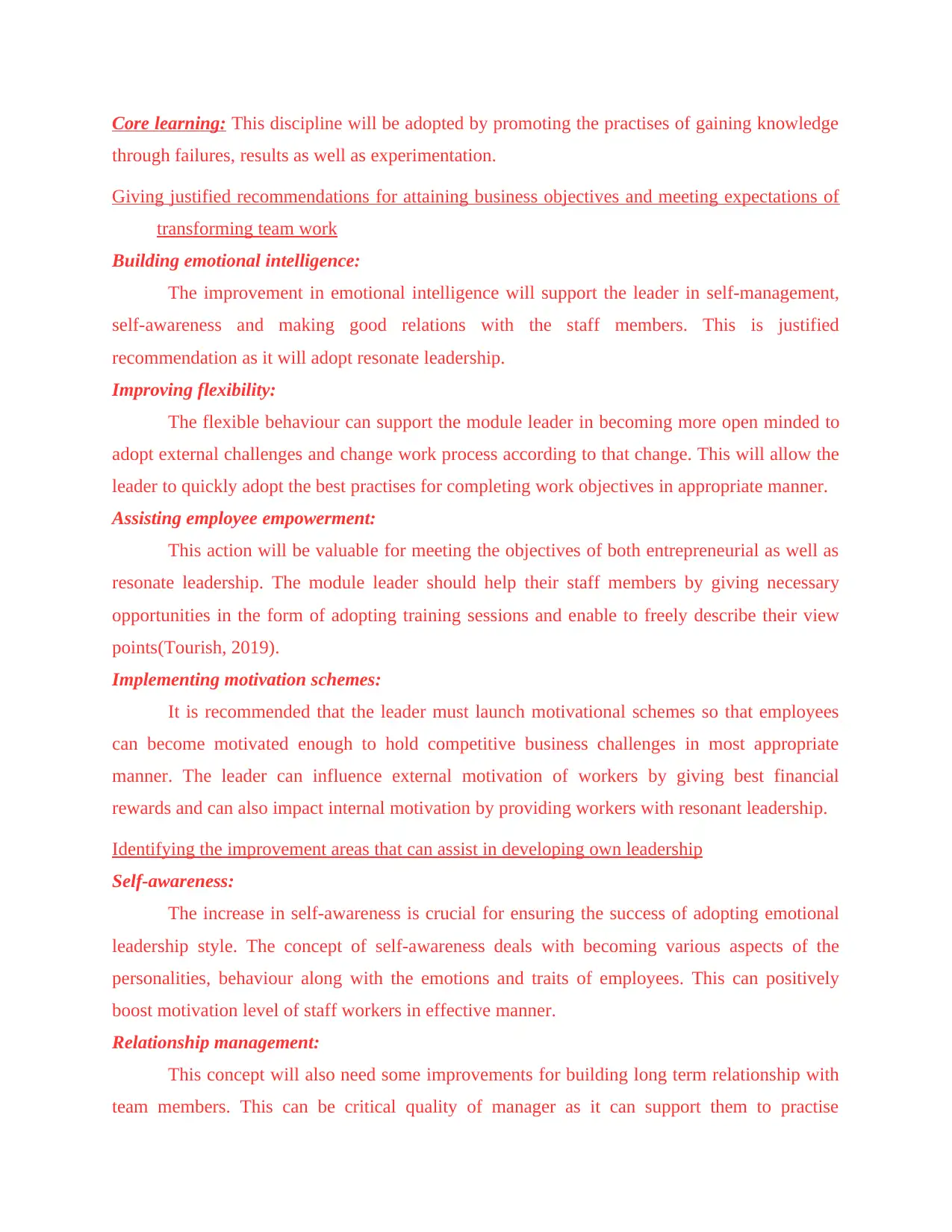
Core learning: This discipline will be adopted by promoting the practises of gaining knowledge
through failures, results as well as experimentation.
Giving justified recommendations for attaining business objectives and meeting expectations of
transforming team work
Building emotional intelligence:
The improvement in emotional intelligence will support the leader in self-management,
self-awareness and making good relations with the staff members. This is justified
recommendation as it will adopt resonate leadership.
Improving flexibility:
The flexible behaviour can support the module leader in becoming more open minded to
adopt external challenges and change work process according to that change. This will allow the
leader to quickly adopt the best practises for completing work objectives in appropriate manner.
Assisting employee empowerment:
This action will be valuable for meeting the objectives of both entrepreneurial as well as
resonate leadership. The module leader should help their staff members by giving necessary
opportunities in the form of adopting training sessions and enable to freely describe their view
points(Tourish, 2019).
Implementing motivation schemes:
It is recommended that the leader must launch motivational schemes so that employees
can become motivated enough to hold competitive business challenges in most appropriate
manner. The leader can influence external motivation of workers by giving best financial
rewards and can also impact internal motivation by providing workers with resonant leadership.
Identifying the improvement areas that can assist in developing own leadership
Self-awareness:
The increase in self-awareness is crucial for ensuring the success of adopting emotional
leadership style. The concept of self-awareness deals with becoming various aspects of the
personalities, behaviour along with the emotions and traits of employees. This can positively
boost motivation level of staff workers in effective manner.
Relationship management:
This concept will also need some improvements for building long term relationship with
team members. This can be critical quality of manager as it can support them to practise
through failures, results as well as experimentation.
Giving justified recommendations for attaining business objectives and meeting expectations of
transforming team work
Building emotional intelligence:
The improvement in emotional intelligence will support the leader in self-management,
self-awareness and making good relations with the staff members. This is justified
recommendation as it will adopt resonate leadership.
Improving flexibility:
The flexible behaviour can support the module leader in becoming more open minded to
adopt external challenges and change work process according to that change. This will allow the
leader to quickly adopt the best practises for completing work objectives in appropriate manner.
Assisting employee empowerment:
This action will be valuable for meeting the objectives of both entrepreneurial as well as
resonate leadership. The module leader should help their staff members by giving necessary
opportunities in the form of adopting training sessions and enable to freely describe their view
points(Tourish, 2019).
Implementing motivation schemes:
It is recommended that the leader must launch motivational schemes so that employees
can become motivated enough to hold competitive business challenges in most appropriate
manner. The leader can influence external motivation of workers by giving best financial
rewards and can also impact internal motivation by providing workers with resonant leadership.
Identifying the improvement areas that can assist in developing own leadership
Self-awareness:
The increase in self-awareness is crucial for ensuring the success of adopting emotional
leadership style. The concept of self-awareness deals with becoming various aspects of the
personalities, behaviour along with the emotions and traits of employees. This can positively
boost motivation level of staff workers in effective manner.
Relationship management:
This concept will also need some improvements for building long term relationship with
team members. This can be critical quality of manager as it can support them to practise
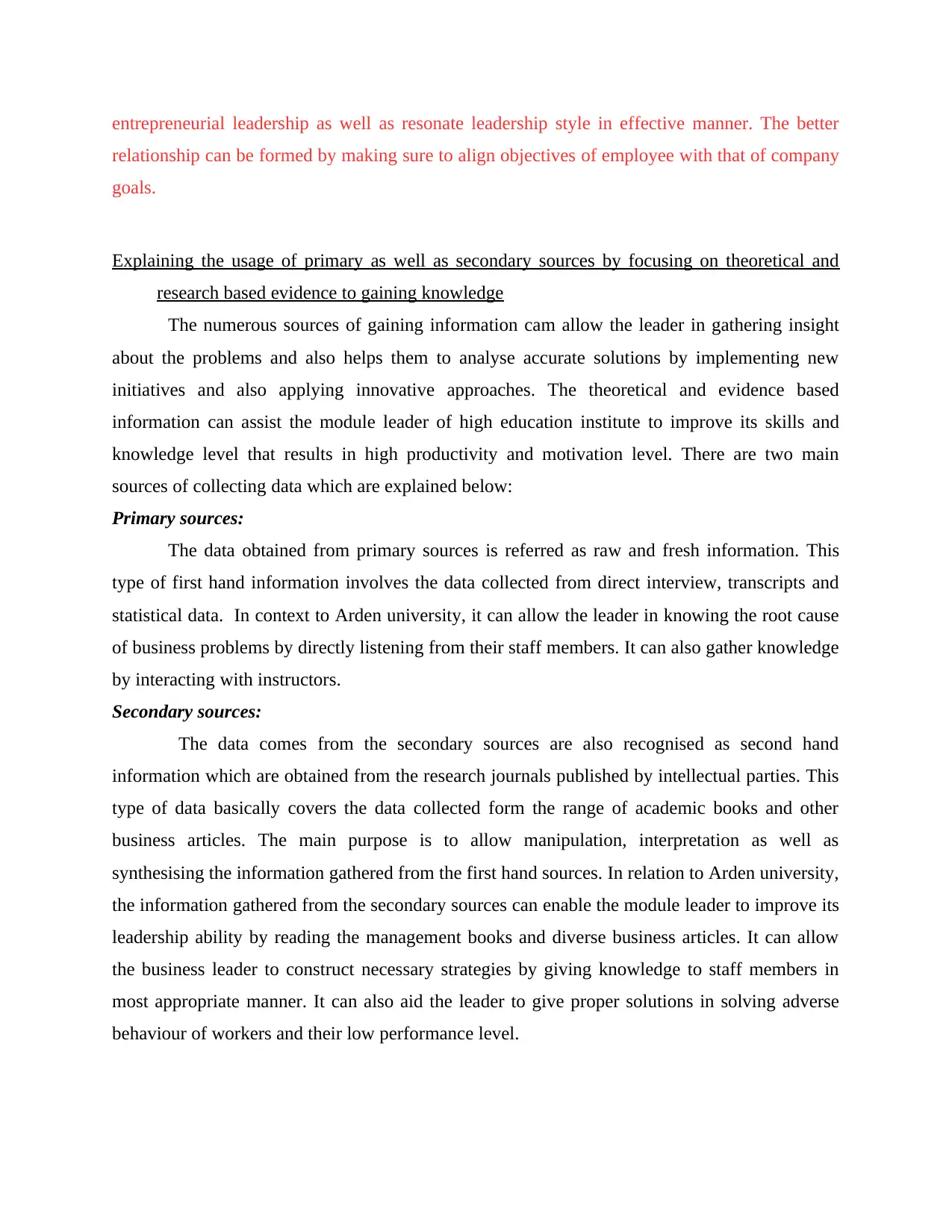
entrepreneurial leadership as well as resonate leadership style in effective manner. The better
relationship can be formed by making sure to align objectives of employee with that of company
goals.
Explaining the usage of primary as well as secondary sources by focusing on theoretical and
research based evidence to gaining knowledge
The numerous sources of gaining information cam allow the leader in gathering insight
about the problems and also helps them to analyse accurate solutions by implementing new
initiatives and also applying innovative approaches. The theoretical and evidence based
information can assist the module leader of high education institute to improve its skills and
knowledge level that results in high productivity and motivation level. There are two main
sources of collecting data which are explained below:
Primary sources:
The data obtained from primary sources is referred as raw and fresh information. This
type of first hand information involves the data collected from direct interview, transcripts and
statistical data. In context to Arden university, it can allow the leader in knowing the root cause
of business problems by directly listening from their staff members. It can also gather knowledge
by interacting with instructors.
Secondary sources:
The data comes from the secondary sources are also recognised as second hand
information which are obtained from the research journals published by intellectual parties. This
type of data basically covers the data collected form the range of academic books and other
business articles. The main purpose is to allow manipulation, interpretation as well as
synthesising the information gathered from the first hand sources. In relation to Arden university,
the information gathered from the secondary sources can enable the module leader to improve its
leadership ability by reading the management books and diverse business articles. It can allow
the business leader to construct necessary strategies by giving knowledge to staff members in
most appropriate manner. It can also aid the leader to give proper solutions in solving adverse
behaviour of workers and their low performance level.
relationship can be formed by making sure to align objectives of employee with that of company
goals.
Explaining the usage of primary as well as secondary sources by focusing on theoretical and
research based evidence to gaining knowledge
The numerous sources of gaining information cam allow the leader in gathering insight
about the problems and also helps them to analyse accurate solutions by implementing new
initiatives and also applying innovative approaches. The theoretical and evidence based
information can assist the module leader of high education institute to improve its skills and
knowledge level that results in high productivity and motivation level. There are two main
sources of collecting data which are explained below:
Primary sources:
The data obtained from primary sources is referred as raw and fresh information. This
type of first hand information involves the data collected from direct interview, transcripts and
statistical data. In context to Arden university, it can allow the leader in knowing the root cause
of business problems by directly listening from their staff members. It can also gather knowledge
by interacting with instructors.
Secondary sources:
The data comes from the secondary sources are also recognised as second hand
information which are obtained from the research journals published by intellectual parties. This
type of data basically covers the data collected form the range of academic books and other
business articles. The main purpose is to allow manipulation, interpretation as well as
synthesising the information gathered from the first hand sources. In relation to Arden university,
the information gathered from the secondary sources can enable the module leader to improve its
leadership ability by reading the management books and diverse business articles. It can allow
the business leader to construct necessary strategies by giving knowledge to staff members in
most appropriate manner. It can also aid the leader to give proper solutions in solving adverse
behaviour of workers and their low performance level.
⊘ This is a preview!⊘
Do you want full access?
Subscribe today to unlock all pages.

Trusted by 1+ million students worldwide
1 out of 19
Related Documents
Your All-in-One AI-Powered Toolkit for Academic Success.
+13062052269
info@desklib.com
Available 24*7 on WhatsApp / Email
![[object Object]](/_next/static/media/star-bottom.7253800d.svg)
Unlock your academic potential
Copyright © 2020–2025 A2Z Services. All Rights Reserved. Developed and managed by ZUCOL.




